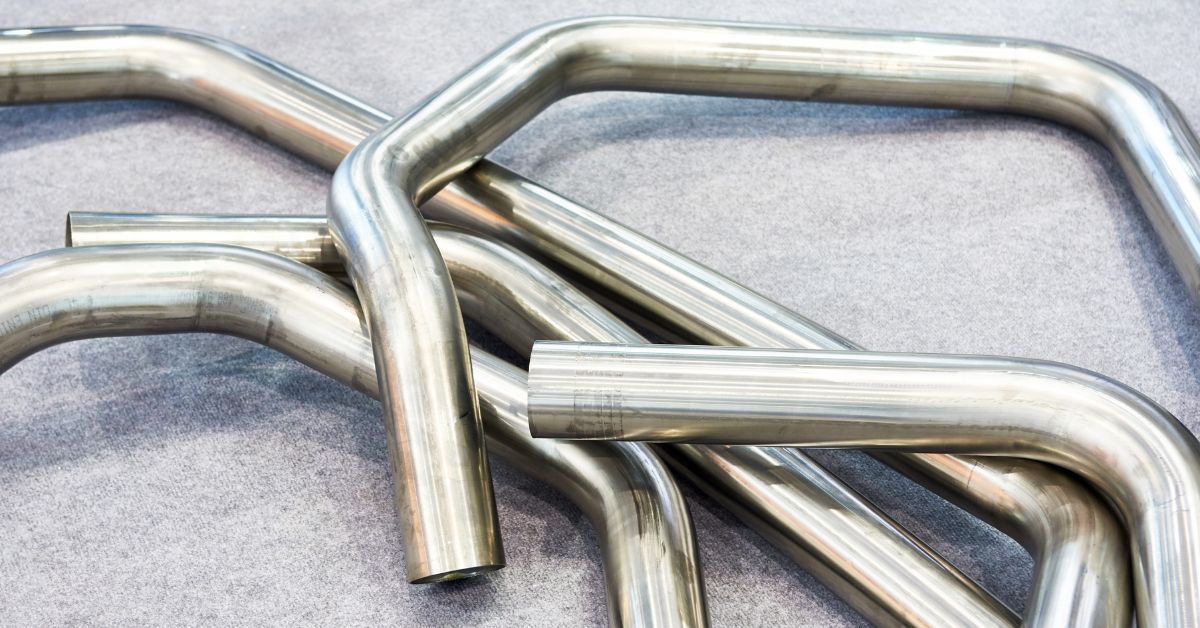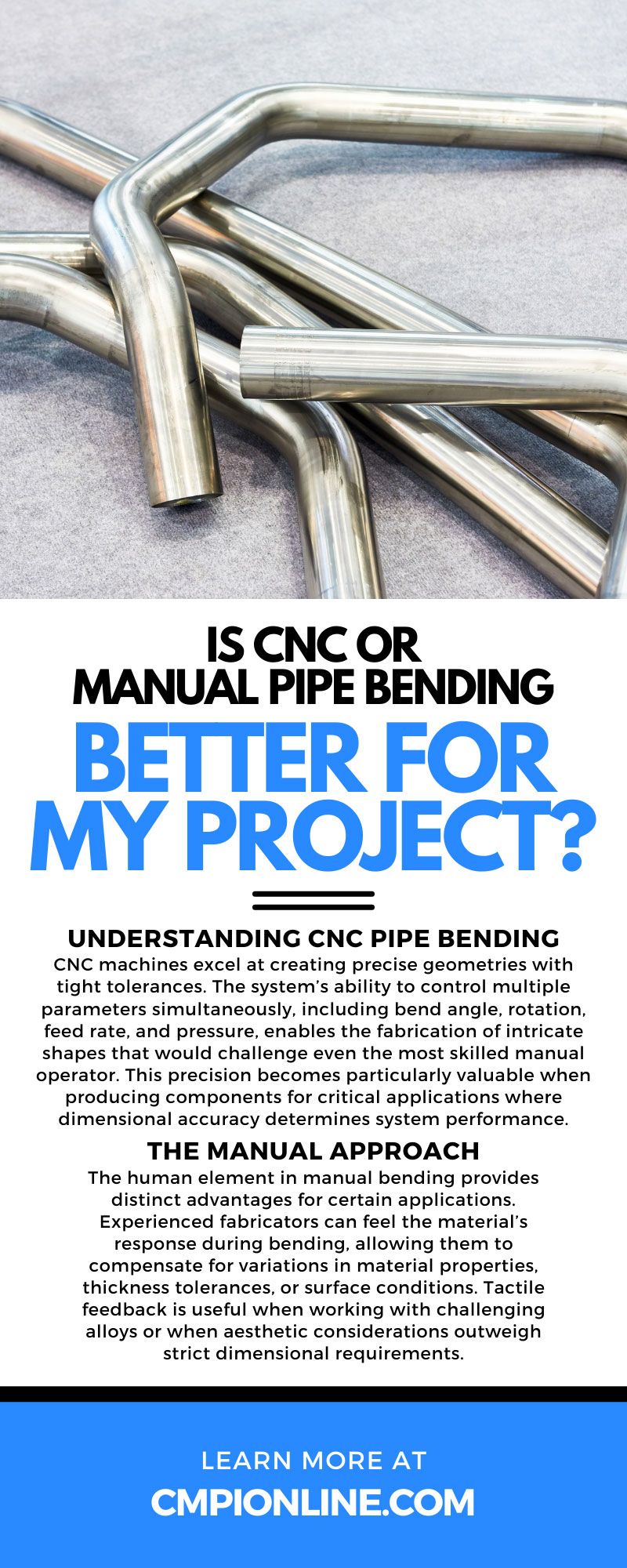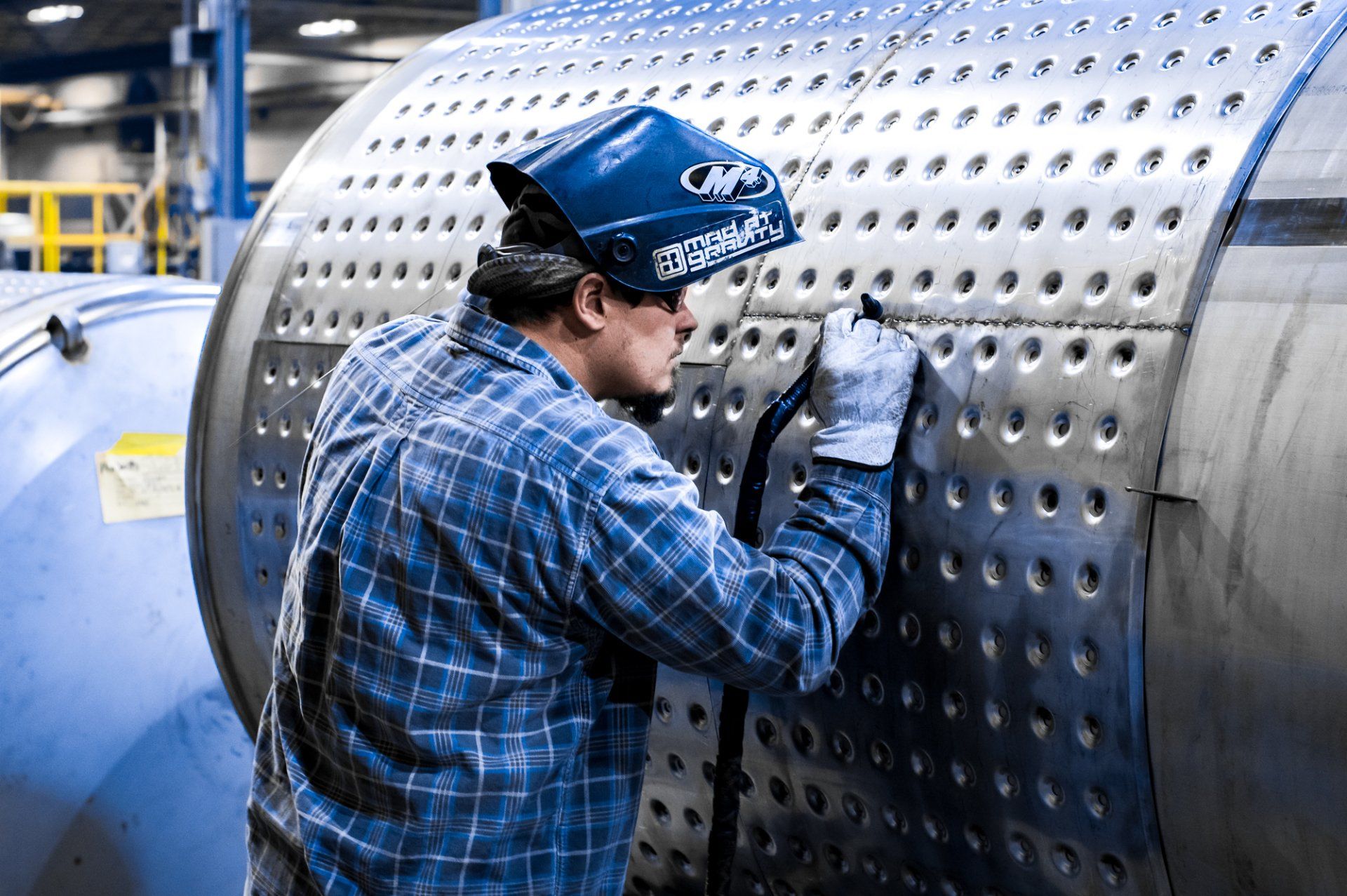Is CNC or Manual Pipe Bending Better for My Project?

If your business works with metal piping, your team will likely have questions about every fabrication. Determining the right pipe-bending approach is especially important. You might hear an engineer ask, “Is CNC or manual pipe bending better for my project?” Or maybe a project manager will wonder, “Which method will deliver the fastest turnaround without sacrificing quality?” The choice between CNC and manual pipe bending affects your budget, lead times, and quality of work. In this guide, we’ll explain the strengths of each method.
Understanding CNC Pipe Bending
Computer numerical control (CNC) pipe bending represents the pinnacle of automated fabrication technology. These sophisticated systems follow programmed specifications with mathematical precision, eliminating human error and ensuring consistent results across large production runs. The technology operates through a series of servo-controlled axes that manipulate the pipe through predetermined bending sequences.
Precision
CNC machines excel at creating precise geometries with tight tolerances. The system’s ability to control multiple parameters simultaneously, including bend angle, rotation, feed rate, and pressure, enables the fabrication of intricate shapes that would challenge even the most skilled manual operator. This precision becomes particularly valuable when producing components for critical applications where dimensional accuracy determines system performance.
Material-Specific Advantages
CNC technology shines when working with demanding materials such as stainless-steel piping. Stainless steel’s unique properties require careful handling to prevent work hardening, surface damage, or dimensional distortion. CNC systems maintain consistent pressure and speed throughout the bending process, reducing the risk of material deformation or cracking.
Advanced Features and Automation
Modern CNC pipe bending machines incorporate advanced features such as automatic tool changing, multi-stack bending capabilities, and integrated quality control systems. These enhancements enable lights-out production, where machines operate unattended for extended periods while maintaining consistent quality standards. The result is increased productivity, reduced labor costs, and improved delivery times for large-volume projects.
The Manual Approach
Manual pipe bending offers flexibility and craftsmanship that automated systems cannot replicate. Skilled operators possess an intuitive understanding of material behavior, developed through years of hands-on experience.
Human Expertise and Tactile Control
The human element in manual bending provides distinct advantages for certain applications. Experienced fabricators can feel the material’s response during bending, allowing them to compensate for variations in material properties, thickness tolerances, or surface conditions. Tactile feedback is useful when working with challenging alloys or when aesthetic considerations outweigh strict dimensional requirements.
Rapid Prototyping and Development
Manual methods excel in prototyping and small-batch production. When developing new products or testing design concepts, the ability to quickly modify bending parameters without reprogramming saves significant time and resources. Operators can experiment with different approaches, make immediate adjustments, and iterate designs rapidly—capabilities that prove invaluable during the development phase.
Custom Applications and Flexibility
Custom applications often benefit from manual techniques. If a project involves unique materials, unusual geometries, or special finishing requirements, skilled artisans can adapt their approach to meet specific needs. This flexibility enables solutions for challenging projects that might overwhelm automated systems or require extensive programming modifications.
Technical Considerations and Material Factors
Material selection influences the choice between CNC and manual bending methods. Different alloys exhibit varying characteristics under stress, affecting how they respond to bending forces.
Wall Thickness Impact
Wall thickness plays a crucial role in method selection. Thin-walled tubing demands precise control to prevent collapse or wrinkling, a perfect job for CNC systems with their consistent pressure application. Thick-walled pipes may require the higher forces available in some manual systems, particularly for tight radius bends that challenge machine capabilities.
Bend Radius Requirements
Bend radius requirements directly impact the feasibility of each method. CNC systems excel at maintaining consistent radius throughout the bend, crucial for applications requiring precise fit or fluid flow characteristics. Manual methods provide flexibility for variable radius bends or situations where slight deviations are acceptable.
Surface Finish Specifications
Surface finish requirements influence method selection. CNC systems typically produce more consistent surface quality, while manual methods may introduce minor variations that could affect appearance or function. Projects requiring pristine surfaces for sanitary applications or aesthetic purposes often favor automated approaches.
Production Volume
If a team member asks whether CNC or manual pipe bending is better for their project, your answer will frequently hinge on volume considerations. Low-volume production often favors manual methods due to reduced setup costs and programming requirements. When producing fewer than 50 pieces, the time investment in CNC programming and tooling setup may exceed the benefits of automated production.
Medium-volume production presents the most complex decision scenario. Projects requiring 50 to 500 pieces may benefit from either approach, depending on complexity and quality requirements. CNC systems provide consistency advantages, while manual methods offer flexibility for design changes during production.
High-volume production typically justifies CNC investment because it results in consistent quality, reduced labor requirements, and faster production cycles.
Lead Time and Scheduling
Timeline requirements significantly influence method selection. CNC setup requires programming and tooling preparation, which can extend initial lead times for new projects. However, once programmed, CNC machines produce parts rapidly and consistently, making them ideal for long-term projects with steady delivery schedules.
Manual bending offers quicker turnaround for simple, low-quantity jobs. Experienced operators can begin production immediately, making this approach valuable for urgent repairs, prototypes, or rush orders. The absence of programming requirements enables a faster response to immediate needs.
Production scheduling flexibility differs between methods. CNC systems require dedicated setup time and may need scheduling around other programmed jobs. Manual operations provide greater flexibility for inserting urgent jobs or accommodating schedule changes.
Real-World Scenarios
To better understand which method might suit your needs, here are a few common project types and the preferred bending approach:
- High-precision industrial piping: CNC ensures every bend aligns perfectly, reducing rework during installation.
- Custom repair work: Manual bending allows for flexibility and real-time adjustments.
- Architectural installations: CNC delivers clean, repeatable curves for decorative elements, while manual methods can be used for one-of-a-kind pieces.
- Marine or aerospace components: CNC’s precision is essential to meet safety and performance standards.
Expert Guidance at CMPI
At Custom Manufacturing & Polishing, Inc., we bring decades of experience to every pipe-bending decision. Our team evaluates each project’s unique requirements, considering specifications, timeline, budget, and quality requirements to recommend the optimal bending method. This comprehensive assessment ensures you receive the most cost-effective solution for your needs.
Call our team today. Whether your project demands CNC precision for complex geometries or manual craftsmanship for prototypes, CMPI can help.






